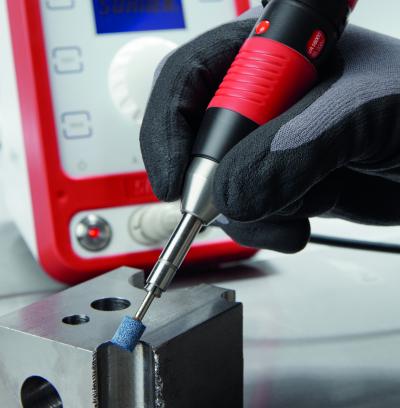
In many technical fields, ultrafine grinding is one of the tasks that gives the product its final polish – in the truest sense of the word. This applies equally to both precision and the visual appeal. SUHNER offers a grinding, milling and polishing system, SUNmic 60.
The central element is an intelligent control unit with touch panel that can accept a range of micro motors and tool hand pieces, depending on the application. The control part has modern features such as touch screen operation on a glass display, the option to save settings and a rotation speed regulator with tangible resistance. Key settings are easily legible on a large digital display.
The actual tools are driven by powerful micromotors whose 280 W place a lot of power in the user’s hand. The compact, brushless BL/DC motors provide a wide speed range of 1,000 to 60,000 rpm and deliver a high torque. In practice, they can be compared with pneumatic technologies but do not need a compressed air supply, operate at lower energy levels and emit virtually zero noise, without exhaust air or oil mist emissions.
One further benefit is that they run virtually free of vibration. The high concentricity safeguards clean and reproducible results in all areas of operation. A special heavy-duty clamping system prevents the millers from shifting. Chuck diameters range from 2.35, 3.0 and 6.0 mm to 1/8 and 1/4 inch.
The new SUNmic 60 micro motor system can be connected to a 90 to 240 V source, and can therefore be used anywhere in the world. It offers a large number of combinations. The tools range from straight, angle and filing hand pieces to belt grinders. The control unit can be connected to two BL/DC motors and an AC motor. Advantage: The new control unit is compatible with available micromotors.
The new system can be used everywhere a precision finish is desired – for instance, grinding, milling, brushing and polishing in tool and mold making; in aircraft, engine and motor building; and in engine tuning. SUHNER offers a range of matching machines, tools and abrasives that have been tailored specifically to each of these applications.
The most important properties of SUNmic 60:
- Robust control unit with intelligent features and uncluttered digital display
- Touch screen operation on glass display
- Rotation speed regulator with tangible resistance
- Two sockets for hand pieces with the new BL/DC motors and one for conventional motors with carbon brushes
- Separate, nonvolatile rotation speed memory for each connection
- Wide, continuous range of rotation speeds of 1000–60,000 rpm
- High torque
- Low-vibration running and noiseless operation
- High concentricity of 0.01 mm
- Manual and automatic workpiece clamping under high forces
- Overload protection, dust and spray water protection
- Option for connecting a pedal
Contact Details
Related Glossary Terms
- brushing
brushing
Generic term for a curve whose shape is controlled by a combination of its control points and knots (parameter values). The placement of the control points is controlled by an application-specific combination of order, tangency constraints and curvature requirements. See NURBS, nonuniform rational B-splines.
- chuck
chuck
Workholding device that affixes to a mill, lathe or drill-press spindle. It holds a tool or workpiece by one end, allowing it to be rotated. May also be fitted to the machine table to hold a workpiece. Two or more adjustable jaws actually hold the tool or part. May be actuated manually, pneumatically, hydraulically or electrically. See collet.
- filing
filing
Operation in which a tool with numerous small teeth is applied manually to round off sharp corners and shoulders and remove burrs and nicks. Although often a manual operation, filing on a power filer or contour band machine with a special filing attachment can be an intermediate step in machining low-volume or one-of-a-kind parts.
- gang cutting ( milling)
gang cutting ( milling)
Machining with several cutters mounted on a single arbor, generally for simultaneous cutting.
- grinding
grinding
Machining operation in which material is removed from the workpiece by a powered abrasive wheel, stone, belt, paste, sheet, compound, slurry, etc. Takes various forms: surface grinding (creates flat and/or squared surfaces); cylindrical grinding (for external cylindrical and tapered shapes, fillets, undercuts, etc.); centerless grinding; chamfering; thread and form grinding; tool and cutter grinding; offhand grinding; lapping and polishing (grinding with extremely fine grits to create ultrasmooth surfaces); honing; and disc grinding.
- milling
milling
Machining operation in which metal or other material is removed by applying power to a rotating cutter. In vertical milling, the cutting tool is mounted vertically on the spindle. In horizontal milling, the cutting tool is mounted horizontally, either directly on the spindle or on an arbor. Horizontal milling is further broken down into conventional milling, where the cutter rotates opposite the direction of feed, or “up” into the workpiece; and climb milling, where the cutter rotates in the direction of feed, or “down” into the workpiece. Milling operations include plane or surface milling, endmilling, facemilling, angle milling, form milling and profiling.
- polishing
polishing
Abrasive process that improves surface finish and blends contours. Abrasive particles attached to a flexible backing abrade the workpiece.
